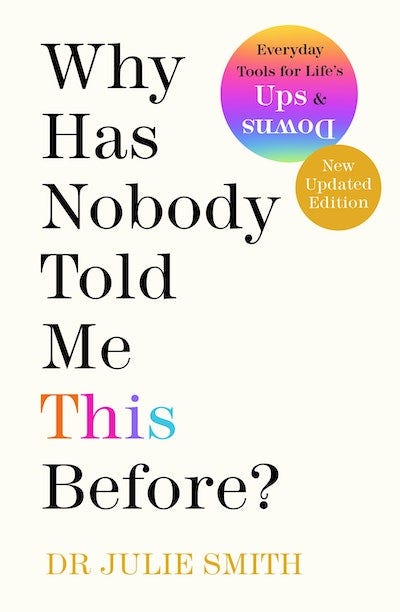Why Has Nobody Told Me This Before? Book Review: The Mental Health Guide That gives you actionable steps
Rating: ⭐⭐⭐⭐⭐ (5/5 stars) A brutally honest review of Dr. Julie Smith's groundbreaking mental health toolkit that is doable.
Why I Picked Up This Book
(And Why You Should Too)
Three months ago, I was sitting in my car after another panic attack in the grocery store parking lot, feeling like my mind was betraying me. I'd been to therapy, tried meditation apps, and read countless self-help books, but nothing seemed to stick. That's when a friend recommended "Why Has Nobody Told Me This Before?" by Dr. Julie Smith.
The title alone hit me. How many times had I wondered why basic emotional skills weren't taught in school? Why did I have to figure out anxiety management through trial and error in my thirties?
What Makes This Book Different
(Spoiler: Everything)
Dr. Julie Smith isn't just another self-help guru. She's a clinical psychologist with over a decade of experience who became a TikTok sensation with 3.4 million followers. But what sets her apart isn't her social media fame—it's her revolutionary approach to mental health education.
The Book That Meets You Where You Are
Smith's work feels like having a conversation with the therapist you wish you had. She takes complex psychological concepts and breaks them down into bite-sized, actionable strategies you can use immediately.
The structure is genius: Eight focused chapters covering depression, motivation, emotional pain, grief, self-doubt, fear, stress, and building a meaningful life. Each chapter stands alone, so you can jump to what you need most right now.
My Personal Journey Through Each Chapter
1.On Dark Places - When Depression Felt Like Quicksand
Reading about Smith's approach to depression was like having someone explain why I felt stuck for months after losing my identity as doctor. She introduces the concept of unmet needs as the root of emotional distress, which completely reframed how I viewed my low moods.
The game-changer: Her "good enough" decision framework. Instead of waiting for perfect conditions to make changes, I learned to make decisions that were simply adequate to move forward. This single concept helped me break out of analysis paralysis that had kept me unemployed for three months.
Personal experiment: I applied this to my job search, sending out "good enough" applications as a writer instead of perfecting each one for weeks. Result? Well the process just begun, so finger crossed.
2: On Motivation - The Lie We've All Been Told
Smith destroys the myth that motivation comes before action. She reveals the truth: action creates motivation, not the other way around.
My breakthrough moment: I'd been waiting to feel motivated to exercise for months. After reading this chapter, I committed to just getting out of the house in the morning—no pressure to actually work out. Within a week, I am walking regularly at least 15 minutes because the action has created the motivation.
3-4: On Emotional Pain and Grief - Permission to Feel
These chapters gave me something I didn't know I needed: permission to feel bad without immediately trying to fix it. Smith explains that sitting with difficult emotions, rather than suppressing them, is crucial for emotional health.
Personal story: When my patient passed away last year, I tried to "stay strong" for everyone else. This book taught me that my attempts to avoid grief were actually prolonging my pain. Learning to process grief properly might have helped more.
The Techniques That Actually Work
1. Square Breathing for Anxiety (My New Superpower)
Smith's square breathing technique has become my go-to for panic attacks. You use any square shape in your environment (window frames, pictures) and breathe in four counts while moving your gaze to each corner, holding for four counts at each corner.
Real-world test: Used this during a job interview when I felt panic rising. It worked well that I actually got through the job interview at least.
2. Thought Bias Recognition
Learning to identify cognitive biases in real-time has been life-changing. Smith teaches you to spot patterns like catastrophizing and all-or-nothing thinking, then challenge their accuracy.
Before: "My partner didn't respond to my text. I'm definitely getting dumped."
After: "My partner didn't respond to my text. That's catastrophizing. There are ten other reasons why he might not have responded."
3. Needs-Based Emotional Analysis
Instead of just feeling bad, Smith teaches you to investigate:
What need isn't being met?
This transforms vague emotional distress into actionable insights.
What This Book Gets Right (Almost Everything)
✅ Accessibility Without Dumbing Down
Smith manages to make complex psychological concepts understandable without losing their depth or effectiveness.
✅ Practical Application
Every technique comes with clear instructions and real-world applications. No abstract theories—just tools you can use today.
✅ Evidence-Based Approach
This isn't pop psychology. Smith backs her methods with clinical experience and psychological research.
✅ Modular Design
You don't need to read cover-to-cover. Jump to the chapter you need most right now.
The Few Things That Could Be Better
❌ Limited Discussion of Systemic Issues
While the individual techniques are powerful, the book doesn't deeply address how external factors (poverty, discrimination, trauma) impact mental health.
❌ Not a Replacement for Therapy
Smith is clear about this, but some readers might use the book to avoid necessary professional help for serious conditions.
Who Should Read This Book?
Perfect for:
Anyone dealing with everyday anxiety, depression, or stress
Caregivers
People who want to understand how their minds work
Maybe not for:
People dealing with severe trauma or complex mental health conditions (therapy first, this book as a supplement)
Those looking for quick fixes without any effort
The Bottom Line: A Mental Health Game-Changer
"Why Has Nobody Told Me This Before?" —it's the mental health education we should have received years ago. Dr. Julie Smith has created something rare: a book that's both professionally credible and genuinely action oriented.
After three months of applying these techniques, I can honestly say my relationship with my mental health is moving in a positive direction. I have tools now. Real, practical tools that work when life gets difficult.
Key Takeaways That Stuck With Me
Mental health care is a skill, not a character trait
Action creates motivation, not the other way around
"Good enough" decisions beat perfect paralysis
Your thoughts are mental habits, not absolute truths
Emotional pain contains valuable information
Final Thoughts: Why You Need This Book
If you've ever felt like you're struggling with your mental health without a roadmap, this book is for you. If you've ever wondered why emotional regulation wasn't taught in school, this book is your answer. If you're tired of expensive therapy being the only path to mental health education, Dr. Julie Smith has created the alternative we've been waiting for.
The title says it all: "Why Has Nobody Told Me This Before?" After reading it, you'll be asking the same question—and grateful that someone finally did tell you.
Buy it. Read it. Use it. Your future self will thank you.
Have you read "Why Has Nobody Told Me This Before?" Share your experience in the comments below. What technique worked best for you?
Her youtube channel-Click here
Her book on amazon- Click here
To Check out My attempt at creating short videos -Click here












🥰👍👍😘😘